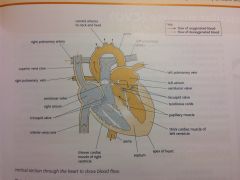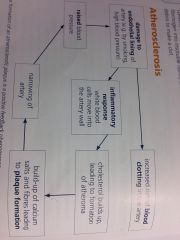![]()
![]()
![]()
Use LEFT and RIGHT arrow keys to navigate between flashcards;
Use UP and DOWN arrow keys to flip the card;
H to show hint;
A reads text to speech;
64 Cards in this Set
- Front
- Back
- 3rd side (hint)
|
Polarity of water molecules
|

The oxygen end is d-, and the hydrogen end is d+
|
Which atoms are more electronegative?
|
|
|
Properties of water
|

Dipole, excellent solvent of POLAR and CHARGED molecules, hydrogen bonding, high specific hear capacity, cohesion.
|
Think about the transport medium and the reasons why water is useful in the body.
|
|
|
Mass transport system
|
Comprised of the heart and circulatory system, this overcomes the limits of diffusion.
|
|
|
|
The structure of arteries
|
Thick walls with smooth muscle, elastic fibres and collagen. The wall is lined with a smooth layer of endothelial cells and the lumen is narrow.
|
|
|
|
The function of arteries
|
Take blood away from the heart. Can withstand high systolic pressures. Smooth muscle can alter the rate of blood flow by changing diameter of artery (vaso-dilation/constriction.) has a low friction surface.
|
|
|
|
The structure of capillaries
|
Very thin (one cell thick) walls. About 10 micrometers across.
|
|
|
|
The function of capillaries
|
Allow rapid exchange of materials between blood and tissue fluid. The thin walls allow quicker diffusion. They can form capillary beds anywhere die to small size.
|
|
|
|
The structure of veins
|
Thin walls with little smooth muscle, elastic tissue or collagen fibres. The wide lumen is lined with valves.
|
|
|
|
The function of veins
|
The blood inside is under low pressure, so there is less need for reinforcement. The valves stop backflow. The wide lumen allows the volume of veins to be very high, and so act as a blood reservoir.
|
High volume allows what?
|
|
|
Important factors in diffusion
|
Surface area, thickness of membrane, concentration gradient across membrane
|
Fick's Law
|
|
|
The structure and function of the lungs
|
Gas exchange occurs through multiple alveoli, maximising surface area. The membranes are very thin and the concentration gradient of gases is very high. Therefore, has exchange is rapid.
|
|
|
|
Why do we use daphnia?
|
They are abundant and easily obtained for experimental use. Being transparent allows easy observation. They have a heart, but a simple nervous system which causes them to feel limited stress/fear.
|
|
|
|
Factors for success in the daphnia experiment
|
One much immobilise the daphnia, control other variables (size of specimens, temperature and light, genders, pH,) make an accurate measurement of heart rate, and repeat the experiment many times.
|
|
|
|
Arteries are separated from the ventricles by:
|
Semilunar valves.
|
|
|
|
The atria and ventricles are separated by:
|
Atrioventricular valves.
|
|
|
|
Valves are closed by:
|
Blood pressure on the reverse side.
|
|
|
|
Structures in the heart
|

|
|
|
|
The cardiac cycle
|
First, atrial, then ventricular systole. Then diastole as the heart relaxes.
|
|
|
|
The usefulness of blood clotting
|
It can prevent blood loss and infection, and allows repair to take place.
|
|
|
|
Blood clotting sequence
|
Platelets release thromboplastin, a clotting factor. In the presence of calcium ions and vitamin K, TP converts prothrombin into active thrombin. This then converts soluble fibrinogen into insoluble fibrin, forming a fibrous net creating a clot from blood debris and cells.
|
|
|
|
Atherosclerosis sequence
|

|
|
|
|
Stroke is:
|
When blood to the brain is cut off by a clot or dislodged fatty deposit.
|
|
|
|
Heart attack is:
|
When coronary blood vessels are blocked and the heart has no blood supply. Cardiac arrest.
|
|
|
|
Angina is:
|
When coronary blood vessels narrow. Accompanied by chest pains.
|
|
|
|
Peripheral vascular disease is:
|
Narrowing of peripheral and limbic arteries and veins, including thrombosis.
|
|
|
|
Risk factors in CVD include:
|
Genetics, age, gender, blood pressure and lifestyle factors.
|
|
|
|
Lifestyle factors in CVD include:
|
Smoking, alcohol intake, exercise, dietary factors such as cholesterol and saturated fat.
|
|
|
|
Medical treatments (and their effects) of CVD include:
|
Antihypertensitives which reduce high blood pressure. Reducing blood cholesterol through the use of statins. Inhibiting blood clotting through the use of anticoagulants or platelet inhibitors.
|
Blood clotting, blood pressure and cholesterol are all factors.
|
|
|
The risks of antihypertensives:
|
Diuretics can cause dizziness and nausea and muscle cramps. Beta-blockers have a link with diabetes. ACE inhibitors have associations with coughs, dizziness, heart arrhythmia and impaired kidney function.
|
|
|
|
The risks of statins:
|
Muscle aches, nausea, constipation and diarrhoea; very rarely inflammation to the liver.
|
|
|
|
The risks of anticoagulants:
|
If bleeding occurs, it may be uncontrolled.
|
|
|
|
Monosaccharides include; their properties are:
|
glucose galactose and fructose. All are soluble and have an osmotic effect. They all function as quick release energy.
|
|
|
|
Sucrose is:
|
A disaccharide comprised of glucose and fructose. Soluble.
|
|
|
|
Lactose is:
|
Comprised of glucose and galactose. Soluble.
|
|
|
|
Maltose is:
|
Glucose and glucose. Soluble.
|
|
|
|
Amylose is:
|
Found in starch. Helical shape with no branches. It is insoluble and has no osmotic effect.
|
|
|
|
Amylopectin is:
|
Found in starch. It is helical and branched. It is in soluble and has no osmotic effect. As there are many terminal groups it can be broken down quickly. It is a compact storage molecule.
|
|
|
|
Glycogen is:
|
Found in animals bacteria and fungi. It has branched chains of glucose molecules. It is compact, insoluble and has no osmotic effect.
|
|
|
|
Saccharides are joined by:
|
Glycosidic bonds. This is formed during a condensation reaction. Hydrolysis can break the sugars apart again.
|
|
|
|
The structure of lipids:
|
A glycerol backbone and three fatty acid chains, joined by ester bonds. Variation occurs in the type of fatty acid chains.
|
|
|
|
Saturated fats:
|
Strong intermolecular bonds and a solid at room temperature .The chain is straight. These contain the most energy of any triglyceride.
|
|
|
|
Unsaturated and polyunsaturated fats:
|
Weak intermolecular bonds and a liquid at room temperature. The chain is kinked. These contain less energy than saturated fats. Polyunsaturated fats have multiple double bonds.
|
|
|
|
Genetics and CVD: (3 points)
|
Genetics can cause a tendency to high blood pressure and poor cholesterol metabolism. Arteries can be more easily damaged.
|
|
|
|
Gender and CVD: (1 point)
|
Oestrogen protect women against CVD up until menopause.
|
|
|
|
Age and CVD: (2 points)
|
Elasticity and width of arteries decreases as one grows older.
|
|
|
|
Diet and CVD: (3 points)
|
Excesses in saturated fats, cholesterol and lipoprotein are risk factors to CVD.
|
|
|
|
LDLs; formation, association:
|
Formed from saturated fats, protein, and cholesterol. Associated with the formation of atherosclerosis. Should be maintained at a low level.
|
|
|
|
HDLs; formation, association:
|
Formed from unsaturated fats, proteins, and cholesterol. Transport cholesterol from body tissues to the liver for breakdown. These reduce blood cholesterol level and discourage atherosclerosis. Be maintained at a high level.
|
|
|
|
BMI formula:
|
Body mass divided by height squared.
|
|
|
|
Cohort studies: (4 points)
|
Large number of people is followed over a long time period. Those who develop the condition are put into one group; various risk factors are then looked at by interviewing and correlations are searched for.
|
|
|
|
Case-control studies. (3 points)
|
A group which does have a condition is compared with a group that does not. The past history of each person is investigated to try and identify risk factors. Other variables such as age and gender must be controlled.
|
|
|
|
Causal links: (2 points)
|
Correlation might imply causation but does not necessitate it. Mechanism of action may need to be found through an experiment to show causality.
|
|
|
|
A good study should: (3 points)
|
The data collected should be valid and reliable. The sample should be representative of the whole population otherwise the sample is biased. Extraneous variables should be controlled. Sample size should be as great as possible.
|
|
|
|
Perception of risk is often affected by: (5 points)
|
Ones own experience, peer pressure, the idea of destiny, anecdotal evidence, and the remoteness of the likely consequences.
|
|
|
|
Vitamin C, use and source:
|
An antioxidant which can reduce the risk of oxidative stress. Often found in fruit juices.
|
|
|
|
Vitamin C experiment and sources of error:
|
Vitamin C in fruit juice is titrated against DCPIP. DCPIP decolourises from dark blue when reduced. Errors include: bad glassware, bad experimental measurements, the endpoint is misjudged, and the vitamin C in juice cannot be added by less than one drop at a time.
|
|
|
|
Damage to arterial endothelium may be caused by:
|
Blood flowing QUICKLY under HIGH PRESSURE or by chemicals such as those in cigarette smoke.
|
|
|
|
When designing a trial:
|
Conduct on large groups, conduct over a long time, control variables which are irrelevant.
|
|
|
|
Capillary cells are:
|
Endothelial cells, one layer thick.
|
|
|
|
Elastic fibres are in:
|
The middle layer of the artery wall, which contains muscular structure.
|
|
|
|
The mammalian heart had two sides because:
|
Separate sides supply the heart and lungs, preventing the mixing of deoxygenated and oxygenated blood. This allows as much oxygen as possible to reach the places where Otis needed. It also allows a lower (safe) pressure to be maintained in the lungs.
|
|
|
|
What types of molecule may easily permeate a cell membrane?
|
Non-polar and lipid soluble.
|
|
|
|
Globular proteins generally are:
|
Quite short polypeptide chains, possessing very many polar R groups.
|
|
|
|
tRNA function:
|
Translation. Is specific to an amino acid and has a matching specific anticodon to a mRNA triplet. It transports AAs to the ribosome and keeps them in place whilst they are being joined.
|
|

